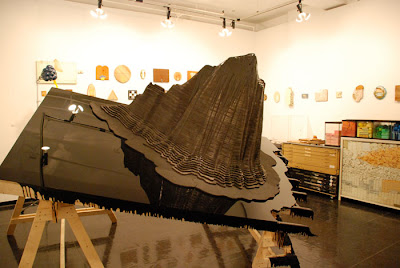CHAPTER 4
Notes of a Formalist Apologist
I don’t see a dichotomy with formalism and something else. Form and formal relations are important because they mean something; their meaning grows out of our experience as physical mortal beings of a particular scale in relationship to the world as we find it and make it. I don’t buy that formalism is meaningless.
-Jessica Stockholder
Jessica Stockholder is a modernist painter who works with post-modernist sculpture. At least this is what I argue in a paper, How to Be Everything and Everywhere all at once: The Allegorical Impulse of Postmodernism in the Modernist Paintings of Jessica Stockholder, for a history class covering post-modern painting with Dr. Robert Hobbs. I choose the topic not only because of my interest in her work as “neither painting nor sculpture”, but as a way to understand and critique where my own work lies in relation between painting and sculpture, formalism and conceptualism, and modernism and post-modernism.
Stockholder’s work is clearly formalist and she invites modernist interpretations by ascribing emotional content to the forms. The arguments placing her within formalist and modernist tendencies is not the issue here, more important is the way Stockholder fits within a post-modernist definition. To do so it is helpful to consider Stockholder’s ‘modernism’ in the context of Craig Owens’ landmark ideas surrounding allegory and postmodernism, Owens defines allegory as “one text doubled by another.” It is a contextual doubling, like when the New Testament is read through the text of the Old Testament; and literal, as when old graffiti is read underneath the new tag covering it. More interestingly, then, in allegory is when “one text is read through another, however fragmentary, intermittent, or chaotic the relationship may be.” Owens' most compelling paradigm for allegory is the palimpsest. The palimpsest is the ancient text on animal skin parchment that has been erased or scraped away, yet is still visible through the new text written over it.” Stockholder’s work is allegorical in this way. It is actually a type of palimpsest itself since the handwritten text of painterly interventions are made on top of actual objects and, therefore, on top of the inherent meanings, functions, and connotations of those objects, or their texts. It is as if Jessica Stockholder recognizes the palimpsest in her work when she says,
My work makes use of the state of things. I make my work on top of what is already there…it is an interweaving of how I see things, how other people see things before me and how people see the work after I make it.
Not only do Stockholder’s abstractions succeed in creating palimpsests, but also they accord figuratively with Owens' list of allegorical impulses so closely that we are compelled to change our appraisal of Stockholder as modernist to viewing her work as representative of the Allegorical Impulse of Postmodernism. Owens’ list of impulses includes site specificity, hybridization of art mediums, appropriation, impermanence, and accumulation – all clearly evident in Stockholder’s oeuvre.
Because of her mastery of ‘combine’ technology, Stockholder is often compared to Robert Rauschenberg. The first impression of work by both artists is often of chaos and randomness. Here are two artists whose style is, deceptively, to include ‘everything and anything’. The randomness of Rauschenberg and Stockholder is deceptive as they actually make chaos cohere into an understandable gestalt. The exuberance that Stockholder and Rauschenberg share is the poetry of limitless possibilities. Its consequence is ephemerality - and this is quintessentially postmodern.
It will be shown in this thesis that my own work, which shares tendencies of formalism and ambiguous identity with the work of Jessica Stockholder, develops on a continuum of the allegorical impulses of post-modernism. Like Stockholder, my work avails itself of accumulations, hybridizations of mediums, appropriation, impermanence, and site specificity and, therefore, is formalist work that defies the notion that formalist work is devoid of content.
I think it is time to show you the artwork i shared thesis space with, beginning with the other artist: Taylor Baldwin.

Taylor and I are the only two artists graduating this year who claim the desert west as home (he is from Arizona)...that is Dr. Hobbs in the background (mentioned in the chapter above)
I'm sure you're wanting a better view of the mountain Taylor made:

I asked Taylor's permission to pun off his cloud sculpture by placing my cloud/bunny tail cutllage behind it.
He was enthused.





No comments:
Post a Comment